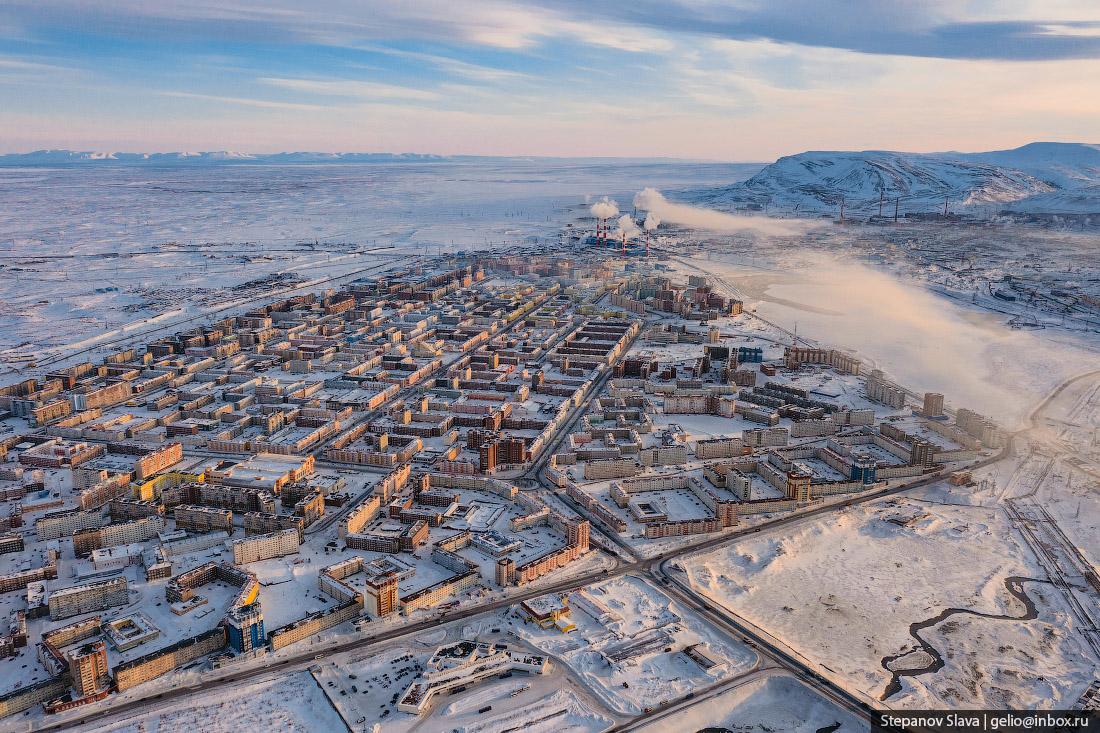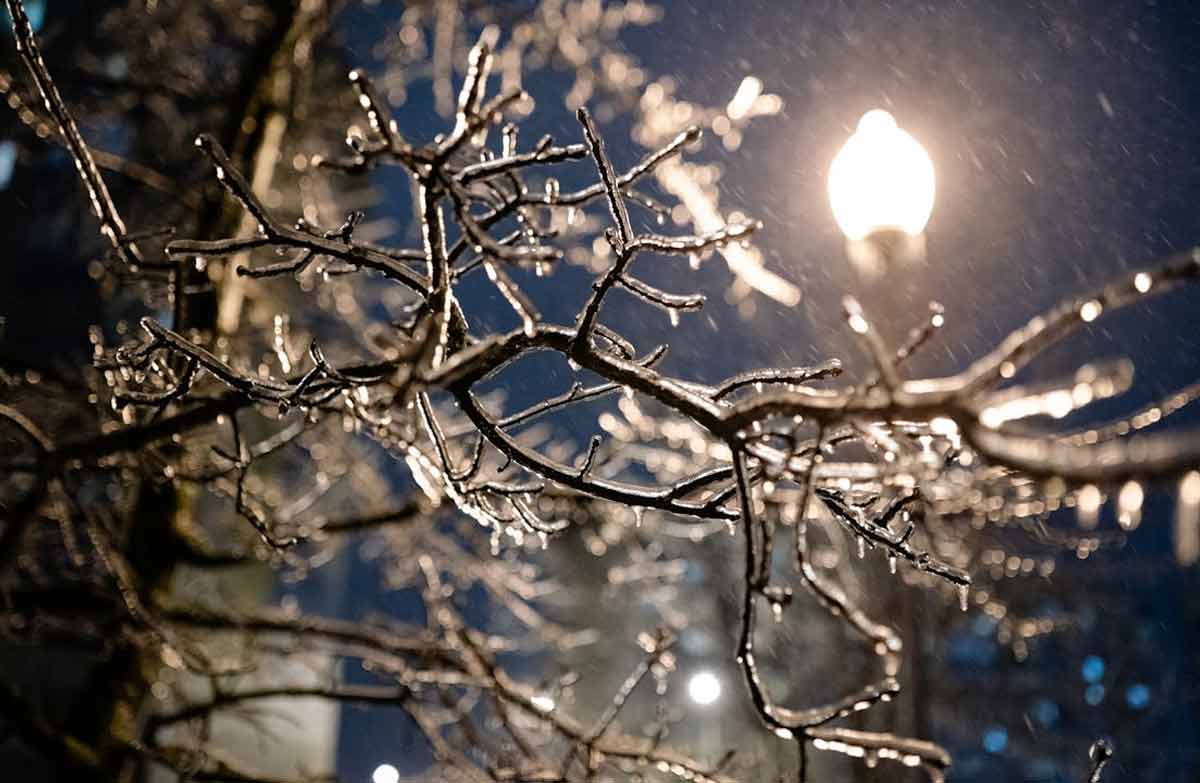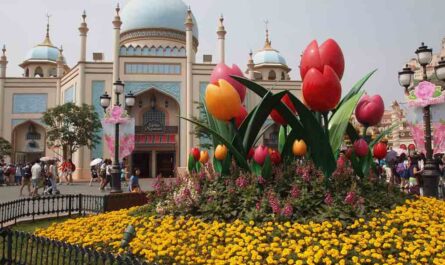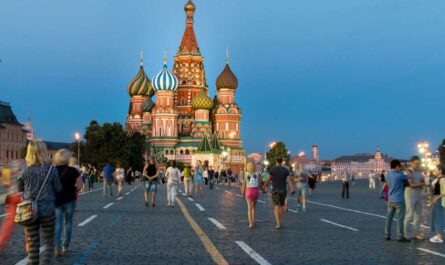There are a lot of interesting facts about Norilsk, Russia that will surprise you. Nestled deep within the vast expanse of the Russian Arctic, Norilsk stands as a testament to human resilience amidst extreme conditions. Situated in the Taymyr Peninsula, above the Arctic Circle, Norilsk is one of the northernmost cities on Earth. Despite its remote location and harsh climate, Norilsk has evolved into a vital industrial hub, primarily driven by its rich mineral deposits, notably nickel, copper, and palladium. The city’s history is intertwined with the development of the Soviet Union’s industrial complex, with its origins dating back to the 1930s when forced labor camps were established in the area. These camps, part of Stalin’s Gulag system, were instrumental in the construction and operation of the city’s mining and metallurgical enterprises. This article will feature many more interesting facts about Norilsk, Russia! Keep reading.
Interesting Facts about Norilsk, Russia (Soviet Union)
Today, Norilsk is home to one of the world’s largest metallurgical and mining complexes, operated by Norilsk Nickel, a global leader in nickel and palladium production. However, the city’s industrial prominence comes at a cost, as environmental degradation and pollution have plagued the region for decades, earning Norilsk the dubious distinction of being one of the most polluted cities on the planet. Despite its challenges, Norilsk remains a testament to human ingenuity and perseverance in the face of formidable natural and industrial obstacles.
1. Beautiful Auroras
Despite the challenges of living in Norilsk, residents are treated to the spectacular sight of the Aurora Borealis, also known as the Northern Lights, during the winter months. These mesmerizing displays of colorful light dancing across the Arctic sky are a source of wonder and awe for both locals and visitors alike. The ethereal beauty of the Aurora Borealis serves as a reminder of the natural wonders that abound in the region, offering moments of tranquility and inspiration amidst the harsh Arctic landscape. Residents of Norilsk often take advantage of clear winter nights to witness this breathtaking phenomenon, which adds a touch of magic to their daily lives.
2. Wildlife Adaptations
Despite the harsh environment of Norilsk, resilient animals such as polar bears, arctic foxes, and various bird species have adapted to thrive in this remote region. These creatures have evolved unique physiological and behavioral adaptations to survive the extreme cold and scarcity of resources, demonstrating the resilience of Arctic wildlife. Despite the challenges posed by the city’s industrial activity and human presence, Norilsk remains a habitat for a diverse range of wildlife, providing a glimpse into the remarkable adaptations of species in the Arctic ecosystem.
3. Midnight Sun and Polar Night
Norilsk experiences the unique natural phenomena of the midnight sun and polar night due to its high latitude within the Arctic Circle. During the summer months, the sun remains visible at midnight, casting a perpetual glow over the landscape and allowing for extended periods of daylight. In contrast, the polar night occurs in winter, with the sun disappearing below the horizon for weeks or months at a time, plunging the city into darkness. These phenomena have profound effects on the daily rhythms of life in Norilsk, shaping everything from sleep patterns to outdoor activities and cultural traditions.
4. Extremely Cold
Norilsk is renowned for its extreme cold temperatures, with average winter temperatures hovering around -30°C (-22°F). These frigid conditions make Norilsk one of the coldest cities in the world, challenging residents to cope with subzero temperatures and harsh winter weather. From bundling up in layers of clothing to ensuring the proper insulation of homes and vehicles, Norilsk residents must take precautions to stay warm and safe during the long winter months. Despite the bone-chilling cold, the city’s inhabitants demonstrate resilience and resourcefulness in adapting to the demanding climate of the Arctic.
5. Short Summers
Norilsk experiences short and cool summers, with average temperatures rarely exceeding 15°C (59°F). The fleeting nature of summer in the Arctic city means that residents must make the most of the warmer weather while it lasts, enjoying outdoor activities and soaking up the sunlight during the brief respite from the long winter months. Despite the relatively mild temperatures, Norilsk’s summer season is characterized by its brevity, providing a stark contrast to the city’s extended periods of cold and darkness.
6. Limited Sunlight
During the winter months, Norilsk experiences limited sunlight, with short days and long nights that can take a toll on residents’ well-being. The polar night phenomenon, where the sun remains below the horizon for extended periods, contributes to feelings of darkness and isolation, impacting daily life and causing seasonal affective disorder (SAD) for some individuals. Coping strategies such as light therapy and outdoor activities during daylight hours are essential for maintaining mental health and combating the effects of prolonged darkness in Norilsk.
7. Siberian Wilderness
Norilsk is situated in the heart of the Siberian wilderness, surrounded by an expansive and rugged landscape characterized by its harsh and unforgiving conditions. The city’s remote location within the Arctic Circle means that it is enveloped by vast stretches of tundra, taiga forests, and frozen rivers, creating a breathtaking yet formidable environment. Despite its natural beauty, the Siberian wilderness presents numerous challenges to those living in Norilsk, including extreme cold, limited resources, and isolation from major population centers. However, for those who appreciate the raw and untouched beauty of nature, Norilsk offers a unique opportunity to experience the pristine landscapes of Siberia.
8. Industrial Domination
The skyline of Norilsk is dominated by the imposing structures of its industrial complexes, which serve as the backbone of the city’s economy. Factories, smelters, and processing plants dot the landscape, their chimneys billowing smoke and steam into the air, creating a dramatic visual contrast against the backdrop of the Siberian wilderness. The industrial domination of Norilsk is a testament to its status as one of the world’s leading centers for mining and metallurgy, with the extraction and processing of nickel, copper, and other valuable minerals driving the city’s economy. While the industrial landscape may appear imposing, it is also a symbol of Norilsk’s resilience and resourcefulness in harnessing the natural resources of the Siberian wilderness for economic development.
9. Air Pollution
Heavy industry and harsh weather conditions contribute to significant air pollution in Norilsk, posing a major health concern for residents. Emissions from mining and metallurgical operations, combined with factors such as coal burning and vehicular traffic, result in high levels of particulate matter and other pollutants in the air. The adverse effects of air pollution on respiratory health are well-documented, with residents of Norilsk facing an increased risk of respiratory ailments and other health problems due to prolonged exposure to polluted air. Efforts to mitigate air pollution and improve air quality are ongoing, but the challenges posed by Norilsk’s industrial activity and environmental conditions remain significant.
10. Shift Work Culture
Many residents of Norilsk are employed in industries that operate around the clock, necessitating shift work to maintain continuous production. This shift work culture can have a significant impact on individuals’ sleep patterns, social lives, and overall well-being. Workers may alternate between day, evening, and night shifts, adjusting their schedules to accommodate the demands of their jobs. While shift work can pose challenges in terms of fatigue and disrupted routines, residents of Norilsk often adapt to this lifestyle with resilience and determination, recognizing the importance of their roles in sustaining the city’s vital industries.
11. Close-Knit Community
Despite the harsh environment and demanding work schedules, those who choose to live in Norilsk often develop a strong sense of community and resilience. The close-knit nature of Norilsk’s population fosters bonds of friendship, support, and solidarity among residents, who come together to navigate the challenges of Arctic living. Whether participating in community events, lending a helping hand to neighbors, or simply sharing stories and experiences, residents of Norilsk find strength in their connections with one another. This sense of camaraderie and mutual aid helps sustain morale and bolster the resilience of individuals and families facing the rigors of life in the Arctic city.
12. Nickel Mining Capital
Norilsk holds the distinction of being the world’s leading producer of nickel and palladium, essential metals that serve as the backbone of the city’s economy. The rich deposits of nickel and palladium found in the region have fueled Norilsk’s growth and prosperity, attracting investment and driving industrial development. The city’s mining operations employ thousands of workers and generate substantial revenue, positioning Norilsk as a global leader in the production of these valuable metals. However, this economic reliance on mining also exposes Norilsk to market fluctuations and environmental challenges, underscoring the need for sustainable resource management practices and diversification of the local economy to ensure long-term stability and resilience.
13. Expatriate Workers
Norilsk attracts a diverse mix of Russian and international workers, drawn primarily by employment opportunities in the mining and metals industry. These expatriate workers contribute to the city’s cultural diversity and bring a wealth of expertise and experience to their respective fields. While some expatriates may relocate temporarily for work assignments, others choose to settle in Norilsk long-term, integrating into the local community and enriching the city’s social fabric. The presence of expatriate workers underscores Norilsk’s status as a global hub for mining and metallurgy, fostering cross-cultural exchanges and collaborations that benefit both the city and its residents.
14. High Salaries
In recognition of the challenging living conditions and remote location, workers in Norilsk receive high salaries to compensate for the hardships they endure. These elevated wages serve as a financial incentive for individuals to relocate to Norilsk and work in industries such as mining, where demand for skilled labor remains strong. The competitive salary packages offered by employers help attract and retain talent, ensuring a steady workforce and supporting the city’s economy. While the high cost of living in Norilsk may offset some of the financial benefits of these salaries, many workers find the opportunity for lucrative employment compelling enough to endure the city’s unique challenges.
15. Limited Cultural Events
Entertainment options in Norilsk may be more limited compared to larger cities, but residents nonetheless find creative ways to celebrate holidays and enjoy leisure activities. While Norilsk may not boast the same array of cultural events and attractions as metropolitan centers, community gatherings, local festivals, and recreational pursuits provide opportunities for residents to socialize, unwind, and connect with one another. From outdoor excursions in the surrounding wilderness to intimate gatherings with friends and family, Norilsk residents embrace a spirit of resilience and camaraderie that transcends the city’s geographical isolation. Despite its remoteness, Norilsk fosters a sense of community and belonging through shared experiences and collective traditions.
16. Environmental Impact
The heavy industries operating in Norilsk have a significant environmental impact, contributing to air and water pollution that poses risks to human health and ecosystems. The extraction and processing of nickel, palladium, and other minerals release pollutants into the atmosphere and waterways, resulting in acid rain, soil contamination, and respiratory ailments among residents. Additionally, industrial accidents and spills have occurred, causing environmental damage and raising concerns about the safety of local communities. Efforts to mitigate the environmental impact of Norilsk’s industrial activities include implementing pollution control measures, investing in cleaner technologies, and monitoring air and water quality to safeguard public health and environmental sustainability.
17. Subsidized City
Due to the harsh living conditions and remote location, Norilsk receives government subsidies to maintain essential services and infrastructure, ensuring the well-being of its residents. The subsidies provided by the government help offset the high costs of living in the Arctic region, including expenses related to housing, utilities, transportation, and healthcare. Additionally, government support enables Norilsk to invest in critical infrastructure projects, such as road maintenance, public utilities, and emergency services, that are essential for the city’s functioning and resilience. Despite the challenges posed by its isolated location and extreme climate, Norilsk remains a subsidized city where government assistance plays a vital role in sustaining the quality of life for its residents and fostering economic development.

18. Challenges for Entrepreneurship
Entrepreneurship in Norilsk presents significant challenges stemming from the city’s extreme environment and limited local market. The harsh Arctic climate and remote location make it difficult to establish and sustain businesses, particularly those reliant on outdoor activities or seasonal tourism. Additionally, the small population size and specialized economy of Norilsk limit the potential customer base for new ventures, posing obstacles to growth and profitability. Despite these challenges, innovative entrepreneurs in Norilsk are exploring niche markets, leveraging digital platforms, and seeking opportunities for collaboration to overcome barriers and build resilient businesses in the face of adversity.
19. Resource Depletion
Norilsk faces concerns regarding the long-term sustainability of its economy and infrastructure as readily available mineral resources begin to dwindle. The city’s growth and prosperity have historically been fueled by the abundant reserves of nickel, copper, and other valuable minerals found in the region. However, as extraction efforts intensify and deposits become increasingly depleted, questions arise about the future viability of Norilsk’s mining industry and its ability to maintain economic stability. To address these challenges, city planners and industry stakeholders are exploring strategies for diversifying the local economy, investing in sustainable resource management practices, and promoting innovation in alternative industries to ensure Norilsk’s continued prosperity beyond the era of resource extraction.
20. Gulag History
Norilsk’s origins are deeply intertwined with the dark legacy of the Soviet Gulag labor camp system, with forced labor playing a significant role in the city’s early development. During the Stalinist era, thousands of political prisoners and laborers were subjected to harsh conditions and exploitation in Norilsk’s labor camps, contributing to the construction of mining infrastructure and industrial facilities. The scars of this history linger in the collective memory of the city, serving as a reminder of the human cost of economic development and the importance of preserving the dignity and rights of all residents. Today, efforts are underway to commemorate the victims of the Gulag system and promote awareness of Norilsk’s complex heritage, fostering dialogue, reconciliation, and a commitment to justice and human rights in the modern era.
21. City Status
Norilsk officially attained city status in 1953, marking a significant milestone in its history of rapid growth and development. The city’s transformation into an urban center was largely driven by the burgeoning mining industry, which attracted a steady influx of workers and investors eager to capitalize on the region’s abundant natural resources. As Norilsk evolved from a remote outpost into a thriving industrial hub, its population swelled, infrastructure expanded, and urban amenities proliferated, laying the foundation for its status as a key economic and cultural center in the Russian Arctic.
22. Arctic Circle City
Norilsk, often referred to as “The City of Nickel,” is located above the Arctic Circle, earning it the distinction of being one of the northernmost cities in the world. Situated in the remote reaches of Siberia, Norilsk experiences extreme Arctic conditions, including long, harsh winters and brief, cool summers. Despite its challenging climate and isolation, Norilsk has emerged as a vital center for mining and metallurgy, particularly in the extraction of nickel, copper, and other valuable minerals. The city’s strategic location near abundant mineral deposits has contributed to its economic significance, attracting workers and industry to this remote Arctic outpost.
23. Permafrost Landscape
Norilsk’s infrastructure is built upon permafrost, a layer of permanently frozen ground that extends deep into the earth. This unique geological feature presents significant challenges for construction and urban development, as buildings and infrastructure must be carefully designed to withstand the shifting and thawing of the underlying permafrost. Engineers and architects in Norilsk employ specialized techniques and materials to mitigate the effects of permafrost on structures, including pilings, insulation, and thermal regulation systems. Despite these challenges, Norilsk continues to expand and evolve, demonstrating the resilience and ingenuity of its inhabitants in adapting to the harsh realities of life in the Arctic.
24. Local Nicknames
Norilsk is known by several monikers that reflect both its challenging environment and the resilience of its inhabitants. While it has earned a reputation as “The City of Death” or “The Most Depressing City on Earth” due to its harsh climate, industrial landscape, and environmental pollution, residents often affectionately refer to it as “Norka,” meaning “little burrow.” This nickname, imbued with a sense of humor and solidarity, underscores the city’s unique character and the tenacity of its people in overcoming adversity. Despite the hardships they face, Norilsk residents embrace their identity with pride and humor, forging strong bonds within their community and finding strength in their shared experiences. How AI, ChatGPT maximizes earnings of many people in minutes
25. Religious Diversity
Despite its remote location and industrial character, Norilsk is home to a diverse religious community, reflecting the multicultural fabric of modern Russia. While Orthodox Christianity remains the predominant faith, with churches and religious institutions dotting the cityscape, other religious traditions are also practiced by various ethnic and cultural groups. Mosques, synagogues, and places of worship for other faiths serve as focal points for religious observance and community gatherings, fostering a spirit of tolerance and coexistence among Norilsk’s diverse population. This religious diversity adds richness and depth to the city’s cultural tapestry, highlighting its status as a melting pot of different beliefs and traditions in the Russian Arctic. Motivation – Mind – Success – Thinking – Productivity – Happiness
26. Focus on Health
Given the unique challenges posed by Norilsk’s harsh environment, maintaining good health is a top priority for residents. Access to quality healthcare facilities and services is essential to address the health needs of the community effectively. Despite the city’s remote location, efforts are made to ensure that healthcare infrastructure meets the needs of the population, with medical professionals trained to handle the specific health concerns associated with living in a cold and isolated environment. Preventive care, health education, and wellness initiatives play a crucial role in promoting overall well-being and resilience among residents. By prioritizing health and investing in healthcare infrastructure, Norilsk aims to safeguard the health and vitality of its population amidst the challenges of its environment. Business – Money Making – Marketing – E-commerce
27. Limited Travel Options
Traveling to and from Norilsk can present significant challenges due to its remote location and limited transportation options. The city’s isolation, coupled with its harsh climate and geographical constraints, can make travel both expensive and logistically complex. Residents and visitors alike must navigate limited flight schedules, weather-related delays, and high transportation costs when traveling to other destinations. Despite these challenges, Norilsk remains connected to the outside world through air and rail links, albeit with limited accessibility compared to more centrally located cities. As a result, travel in and out of Norilsk requires careful planning and flexibility, with residents adapting to the unique logistical considerations of living in a remote northern outpost. Health books, guides, exercises, habits, Diets, and more
28. Unique Architectural Style
Norilsk’s architectural landscape reflects its functional and utilitarian design aesthetic, shaped by the need to withstand the city’s harsh climate and challenging environment. Buildings in Norilsk are characterized by their robust construction, insulation, and heating systems, designed to withstand extreme cold temperatures and heavy snowfall. The city’s architecture prioritizes functionality and durability over aesthetic considerations, resulting in a distinctive urban landscape defined by practicality and resilience. Despite the predominance of utilitarian architecture, Norilsk’s built environment bears witness to the ingenuity and resourcefulness of its inhabitants, who have adapted to thrive in one of the world’s most inhospitable climates. Fitness – Meditation – Diet – Weight Loss – Healthy Living – Yoga
29. Adapting to Change
In response to the shifting economic landscape and growing environmental concerns, Norilsk is actively exploring strategies to diversify its economy and foster sustainability for the future. As a city heavily reliant on extractive industries such as mining and metallurgy, Norilsk recognizes the importance of reducing its environmental footprint and embracing more sustainable practices. Efforts are underway to invest in alternative industries, such as renewable energy, tourism, and technology, to create a more balanced and resilient economy. Additionally, initiatives aimed at improving environmental stewardship, such as reducing pollution and restoring ecosystems, are being prioritized to mitigate the city’s impact on the surrounding environment. Through innovation, collaboration, and forward-thinking policies, Norilsk is striving to adapt to changing global trends and ensure a prosperous and sustainable future for generations to come. RPM 3.0 – 60% CONVERSION & Money for Affiliate Marketing
30. Enduring Spirit
Despite the formidable challenges posed by its remote location and harsh climate, Norilsk and its residents embody an enduring spirit characterized by resilience, perseverance, and adaptation. For decades, the people of Norilsk have weathered extreme weather conditions, environmental hazards, and isolation, demonstrating remarkable strength and determination in the face of adversity. Whether confronting natural disasters, economic hardships, or social upheaval, the community’s unwavering resolve and sense of solidarity have enabled it to overcome obstacles and thrive in the most challenging of circumstances. Through shared experiences, mutual support, and a deep connection to their surroundings, the residents of Norilsk have forged a strong and resilient community that continues to endure and persevere, inspiring resilience and hope in the face of adversity.
More Interesting Articles
- 25 California Drought Facts – Causes | Effects | Solution
- 38 Interesting Facts About Australian Flag
- 25 Interesting Facts About The Roman Empire
- 100 Fun Facts About France One Should Know
- 15 Facts About Letchworth State Park, NY
- 40 Amazing Walt Disney World Facts
- 25 Interesting Facts About Glastonbury Festival
- 10 Interesting Facts About Antalya Turkey
- 70 Interesting Facts about the Eiffel Tower
- 26 Facts About Tokyo Meiji Jingu Temple
- 20 Fun Facts about Yosemite National Park, California
- 30 Interesting Facts About Dublin, Ireland
- 57 Must-do Things in Budapest for Travelers
- 13 Interesting Beijing Facts Everyone Must Know
- 16 Facts – Harbin International Ice and Snow Sculpture Festival
- 20 Surprising Facts About The German Flag
- 25 Surprising Facts About Florida Flag
- 17 Interesting Netherlands Facts to Surprise All
- 100 Tallest Completed Buildings in the World
- 15 Interesting Louvre Museum Facts to Know



